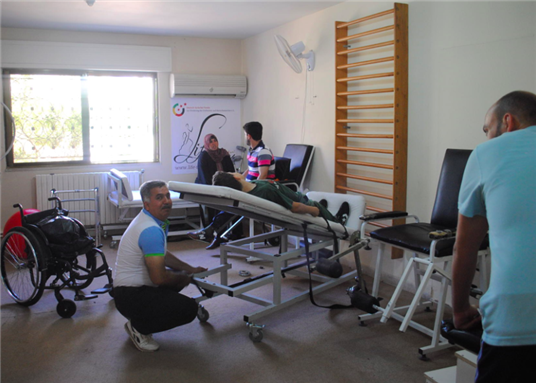Introduction
I first visited the northern city of Irbid, Jordan in the summer of 2013 as an American undergraduate studying Arabic. By joining a youth volunteer group, I came into contact with Syrian social workers who mobilize resources and services among the Syrian community to assist new Syrian arrivals, including injured ex- fighters of the Free Syrian Army (FSA). On my visits to Syrian neighborhoods, I heard a wealth of personal narratives of suffering and resilience that impressed upon me the solidarity of the Syrian community throughout this protracted Syrian war. Now in a Jordanian city, it seemed that refugees also faced state-imposed obstacles to securing a dignified life. Realizing the extent of Syrian civil networks and observing their general support for and ties to the FSA, I decided to create a research design that explores the political implications of Syrian community networks and their interactions with the Jordanian state.
Under the auspices of the WAFAW project, I conducted five weeks of fieldwork (interviews and observation) in the summer of 2014 in Syrian communities in Amman, Irbid, Zarqa, Ramtha, and al-Mafraq, Jordan. The research protocol underwent rigorous evaluation by Swarthmore College’s Institutional Review Board for ethical research with human subjects. The protocol for this research included measures for protecting the anonymity of all participants and for reducing the risks of coercion or exploitation in recruiting and in interviewing participants.
My fieldwork comprised of visits to Syrian community centers, hospitals, rehabilitation centers, and housing units for injured ex-fighters of the Free Syrian Army (FSA). Among the individuals that participated in my research were female and male heads of clinics, doctors, mental health workers, social workers, founders of NGOs, artists, actors, lawyers, FSA leaders and fighters, and a human rights documenter. They came from Damascus and its countryside towns (Rif Dimashq) but mainly from the southern city and countryside of Dera’a. All of those I interviewed had relatively secure financial situations and were committed in varying degrees to providing goods or services to struggling Syrians, both in Jordan and in Syria. My research question also explored Jordan’s policies toward and involvement in Syrian refugee registration and control. Thus, I interviewed various state and security officials particularly, Health Ministry workers and Jordanian border security officials.
My decision to study Jordanian refugee policies through interviews with members of urban Syrian refugee communities upholds this research’s main objective—recovering the lost voices that are not frequently represented in official sources and documents. I began this project by reading a wide array of press sources (Jordanian state-media and prominent Arab publications) to understand how varying media sources portray Jordan’s policies toward Syrian refugees. I then compared this information to reports published by NGOs that quantify the wellbeing of Syrian refugees in Jordan and study the effects of hosting Syrian refugees on Jordanian society, politics, and economy.
The use of interviews and participant observation served to validate official government statements and aggregated data presented in NGO reports. While my research methods are not easily reproducible, conducting fieldwork with members of the affected community allowed me to measure the extent and the effects of refugee policies as they are really enacted. Through my visits to the offices of Jordanian ministers and military officials, I was also able to inquire into the political climate that surrounds Syrian refugee matters. Where my questions were not answered, I could discern which aspects of the state’s policies were politically sensitive, and with further research, why this was the case.
Gaining the trust of my participants was central to my research. I observed that many shared a distrust of outsiders, which may be related to the fact that many in this community recently fled from a state of severe policing and civil war where rumors, arrests, torture, and killings are the norm. The omnipresence of the Jordanian mukhabarat (The General Intelligence Directorate) around Syrian affairs only aggravated this distrust. Therefore, gauging how I was perceived, not just by participants, but by all with whom I came in contact during my fieldwork, was crucial. My age (an undergraduate student) and my ties to the Syrian community (as a Venezuelan-American with no Arab origins) often perplexed participants. However, I was often able to offset their reluctance by emphasizing my concern for safely conducting this research and for using this research to inform others of the struggles of this community. My ease in colloquial Arabic as well as my decision to work with a local research assistant helped to present my research project and myself in positive light.
The context around the Syrian communities I was studying—the suffering stemming from the violence in Syria and all of its consequences— imbues this research. Hearing the tragic personal stories of participants and others I encountered during this fieldwork was inevitable. It continues to be a challenge to separate these personal interactions from the act of conducting and analyzing research. This has fueled the obligation I feel to make this research beneficial to these communities—to have humanitarian as well as academic uses.
My research applies ethnographic methods to the study of power— that is, where power lies in refugee support networks, in refugee control, in Syria’s political and armed opposition, and in Syria-Jordan relations. It is important to note that I have adopted the 1951 Refugee Convention’s definition of refugee, which considers any individual who has fled dangerous home conditions refugee, even before he or she formally obtains refugee status.[1] Rather than focusing on individual Syrian refugees, I am concerned with how collectives form and operate in Jordan’s Syrian refugee communities, and how these collectives interact with the Jordanian state.
This research contributes to an ongoing body of literature on the workings of informal networks and their bearing on macro-political forces in the Middle East, where, as Quintan Wiktorowicz observes, “informal networks are an indelible component of the social matrix.”[2] Here, I define informal networks as the community-level movement of goods, services, and information that serve as an alternative to state institutions and procedures, which often exclude marginalized populations. My definition is based on Wiktorowicz’s work on underground Salafi networks in Jordan and on the previous framework established by Diane Singerman in her ethnographic study of grassroots politics and economic transactions in a sha’bi (popular) Cairene neighborhood.[3] She affirms that states generally ignore informal groups and transactions so long as they do not “become vehicles for opposition and resistance or merely work against the interests of state policy.”[4] My own research fills in this lacuna by demonstrating how the Jordanian state attempts to regulate the workings of Syrian community networks and the movement of Syrian individuals. This is precisely because the Jordanian state perceives potential threats to its interests among Syrian refugee communities, both in the context of the nearby Syrian war and complex refugee politics in Jordan.
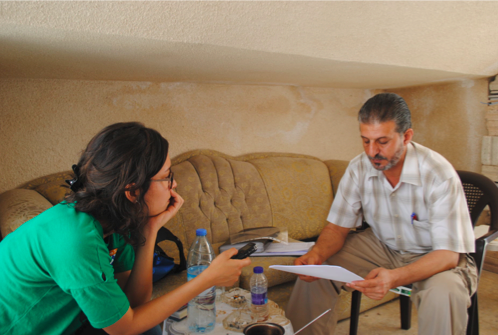
[Interview with human rights documenter, Irbid, 07/2014]
Conflict Context
The steady devolution of what was once hoped to be Syria’s revolution has inevitably pushed large flows of Syrians into Jordan’s refugee camps and urban areas. I have gathered various testimonials of those present during the March 2011 protests in Dera’a and soon after in Damascus and Aleppo. These first-hand accounts support the dominant narrative that recounts the police and military brutality that suppressed the originally peaceful protests in these and other urban centers. Various testimonials also tell of the defections of ex-regime intelligence and military officials that led to the formation of the Free Syrian Army. This was Syria’s main oppositional force before the entrance of multitude of armed, primarily extremist ideological groups, the strongest now being the Islamic State and Jabhat an-Nusra, who have largely overshadowed the FSA in organization and military prowess. Most importantly, many of these testimonials recount the ongoing onslaught by regime forces in civilian areas in Dera’a City and the Dera’a and Damascene countryside, by means of tanks, barrel bombs dropped from airplanes, snipers, and landmines. Syrians who have left their homes for Jordan have frequently explained that their decision to flee Syria preempted or came as a result of these attacks. In other cases, the civilian victims of these attacks were escorted by the Free Syrian Army and then by Jordanian border security to Jordanian hospitals where they received life-saving medical treatment.
Jordanian policies toward entering and residing Syrians have evolved along with the almost four-year conflict. Jordanian border security has, from the beginning, played a generous role in facilitating border crossings, ending the long, dangerous journeys of fleeing Syrians. Various Jordanian officials in my interviews emphasized the extent of humanitarian care that Jordan provides entering Syrians, in partnership with the UN High Commissioner for Refugees (UNHCR), from the border onward. Unlike nearby Lebanon, the Jordanian government has worked with the UNHCR to open al-Za’tari and al-Azraq refugee camps. Other camps include Cyber City, a holding facility for “illegal” Palestinian refugees from Syria (often referred to as PRS) and the Emirati (UAE-funded) camp.
Keeping a close count of registered Syrian refugees is difficult. Many Syrians enter Jordan illegally by bypassing official checkpoints. Increasingly, this is due to intensifying battles over border crossings between Jabhat an-Nusra, the Free Syrian Army, and al-Asad’s forces, and Jordan’s subsequent closing of bordering crossings.[1] Meanwhile, about a hundred thousand Syrians who once resided in Jordan’s refugee camps have voluntarily returned to Syria. Many have also escaped the camps for Jordan’s cities and rural areas in order to seek better conditions and work opportunities.[2] Thus, roughly twenty percent of Syrians in Jordan face poor camp conditions.[3] Overcrowding and poor sanitation prevail, especially in al-Za’tari and Cyber City camps, despite the efforts of camp officials.
Meanwhile, eighty percent of Syrians now live outside Jordan’s refugee camps and struggle to obtain necessary goods and services. With the help of UN-subsidies, Jordan kept its public hospitals open to Syrian refugees for over three years, allowing refugees to access free healthcare. State officials abruptly announced the termination of these services in late November 2014, citing the heavy debts Jordan has accrued through extending free healthcare to Syrian refugees.[4] Education is also difficult to access for young Syrian refugees. Often, this is due to difficult home situations, but also due to the challenges in accommodating high numbers of school-aged Syrians in Jordanian classrooms. Most Syrians struggle to survive off of meager food vouchers and many refuse to rely on aid organizations. While Jordanian work permits are costly and rarely distributed, refugees risk punishment from Jordanian authorities by taking informal and black market jobs. Indeed, conditions for Syrians in Jordan have only become more difficult.
During the summer of 2014, rumors began to circulate in the international press about Jordan’s repatriation of illegal Syrian workers and the strict limits imposed on Syrian refugees waiting to enter from the border. Syrian social workers reported cases of Jordanian authorities forcefully relocating unregistered urban refugees to live in refugee camps. The interviews I conducted this summer with Syrian social workers upheld these claims. Meanwhile, official Jordanian press denied Jordan’s involvement in deporting refugees back to Syria.[5] Months later, international organizations and researchers have been able to substantiate these claims. A November 2014 report released by Boston University (BU) compiles interviews with international organizations and the testimonials of affected Syrians, providing conclusive evidence of Jordan’s practice of forced-repatriation. In fact, escalating concerns over refugee control and domestic security have created a charged political climate surrounding these matters. It is clear that new security priorities have prompted authorities to deport threatening and nonthreatening Syrian refugees alike. As the BU report states, “Syrian nationals are being deported in some instances for violating laws, such as working illegally. Others are deported for posing security problems, usually as a result of political actions, regardless of specific affiliation.”[6] Through this harsh practice, Jordan may damage its international image, even if the kingdom is not a signee of the 1951 Refugee Convention.
As my initial research question hypothesized, security concerns have come to dominate the Jordanian government’s approach to hosting Syrian refugees. According to the same Boston University report, Jordan’s Ministry of the Interior, particularly the Department of Security Intelligence, has assumed a head role in the registration and monitoring of Syrian refugees. The government recently replaced the Jordanian non-profit, the Jordanian Hashemite Charity Organization (JHCO), with an organization headed by the Ministry of Interior, the Syrian Refugee Camp Directorate, to direct al-Za’tari camp. Such moves exemplify the government’s push to address Syrian matters “through a national security lens.”[7]
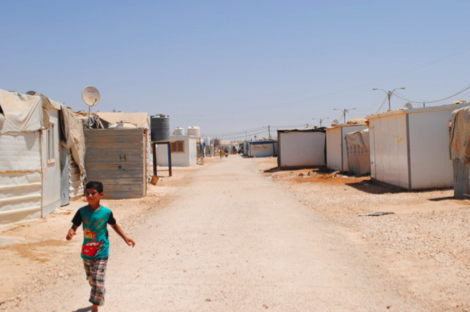
[Al-Za’tari Camp, 08/ 2014]
A Survey of Syrian Social Networks in Jordan
In his study of Islamist organizations in Jordan, Quintan Wiktorowicz concludes that the Jordanian state exercises authoritarian control over civil society formation and practices.[1] Jordan’s General Intelligence Directorate, the mukhabarat, are a major force in regulating the content and activities of political parties, charities, and cultural organizations. While this holds true for Jordanian organizations, I discovered through my survey of civil society formation in Syrian refugee communities that among this population, Jordan is only selectively regulatory. In other words, the state allows some organizations and groups to operate freely while others are closely monitored or banned altogether. An exploration of what is permitted and under what circumstances helps reveal the logic that steers Jordan’s refugee policy, and by extension, its political position toward the Syrian war.
Having recourse to informal networks in Jordan’s Syrian community allows refugees to obtain necessary goods and services that are otherwise inaccessible to them. Urban Syrian communities are made up of refugees from all socioeconomic backgrounds, living outside of the refugee camps. These communities take in bailouts from refugee camps as well as refugees who arrive directly from Syria, other parts of the region, and even the world. Among this diverse group of Syrians are “haves” and “have-nots”, the undoubtedly marginalized and the better integrated. Community dynamics are determined, in large part, by the divide between those who are able to provide resources and services and those who seek these out. Within this context, Syrian communities have increasingly collectivized. Some provide humanitarian aid to civilians or search for ways to support Syria’s political and armed opposition. Divisions between civilian and non-civilian circles are hazy and often overlap.
In my interviews with Syrian founders of community centers, human rights documenters, groups of doctors, FSA leaders, and FSA supporters, I observed the pragmatic decisions that groups make in order to ensure their chances of existing and operating in Jordan. They both anticipate and react to the decisions of Jordanian state institutions. This is reflected in their decision to operate formally, through registration and compliance, or informally, without government recognition or support.[2]
In Irbid, the only surviving Syrian family support center (as of July 2014) has taken pains to abide by strict regulation requirements. The founder (a former activist from Dera’a) not only sought the assistance of a European NGO partner, but also created two paid positions for Jordanian workers, a heavy burden for a struggling non-profit, in order to justify its right to operate in Jordan. “If I didn’t do this, the authorities would close me down immediately,” she explained, referring to Jordan’s Ministry of Social Development. Institutionalization may bring peace of mind, but it does not guarantee government support or the ability to attract international aid. These activists and humanitarians who run these centers rely on a transnational web of Syrians that links wealthy financial donors living abroad (often in Gulf countries) to victims of the Syrian war. Syrian organizations and centers often serve as liaisons, mobilizing their social media networks to advertise pressing cases of those in their communities (injuries, destitution, those unjustly imprisoned in Syria) to activists and potential donors both within and outside their direct communities.
Another member of the Syrian community in Irbid established a sort of civil registry office in his living room, reprinting legal documents for Syrians who left paperwork behind or whose documents have expired. Syrians from various communities in North Jordan come to Irbid seeking his services. For over a year, this activist has also assembled teams of Syrian activists to document human rights violations and civilian deaths wherever they occur in Syria. Volunteers in his office use testimonies and different methods of verification to create reports with titles like, “Violence Against Girls and Women in Dera’a” and “Attacks on Field Hospitals in Aleppo.”
The founder claims that when his documents first began surfacing, their facts contradicted information published by the Syrian National Coalition (SNC). He relates this to the Jordanian mukhabarat’s attempts to shut down his center—that is, until Jordanian authorities assessed the quality of his work. He provides legal documents in hopes that they will be recognized by the Jordanian government and by international organizations. Meanwhile, his human rights work ties his center to political leaders, various armed opposition groups, journalists, activists, arms-traffickers, and local coordinating committees in Syria and neighboring countries. The capacity to get quantifiable evidence on events in Syria from Jordan is a testament to the organization and coherence of the transnational networks that bind the larger Syrian community.
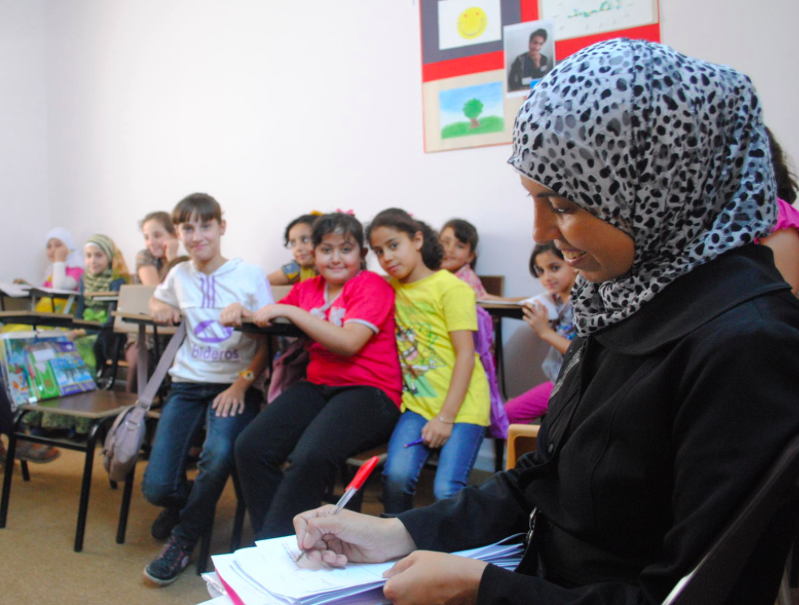
[Syrian community center, Irbid, 08/2014]
Extending Support to Non-Civilians
Informal networks that include non-civilians, particularly those that connect Syrian refugee communities to armed opposition groups in Syria, work in fairly similar ways. As Syrians collectivize to address civilian needs, it is not uncommon for them to engage with Syrians who have political and military affiliations. During my own experiences visiting ostensibly civilian Syrian community centers, I encountered individuals who play more direct roles in the Syrian opposition on a regular basis: field doctors from battle sites in Dera’a, leaders of different divisions of South Syria’s FSA, prominent political activists and dissidents, and arms collectors. They often share familial or hometown ties to Syrian community leaders in Jordan and use the resources made available by community networks to collect funds and supplies, relocate their families to Jordan, spread news, and discuss opposition strategies. As more Syrians flee to Jordan, the dynamics of civilian versus non-civilian become increasingly complex.
The majority of Syrian refugees in Jordan side with the Syrian opposition. Most come from Dera’a and Damascus’ countryside, a region which has been largely divided between FSA-controlled and regime-held areas. Many have faced the dire consequences of regime-attacks on civilian areas and the intense back-and-forth between the regime and the FSA. However, it is important to distinguish armed opposition from Syria’s formal political opposition, represented by the Syrian National Coalition (SNC) and other related bodies. During the of summer 2014, the Syrian refugees I encountered in my fieldwork overwhelmingly sided with the FSA forces while almost never identifying with the public political figures of the SNC, who are thought to prioritize unavailing diplomacy and negotiations over the real needs of the greater Syrian community.
The relative ease with which Syrians in Jordan connect and support members of Syria’s opposition occurs in the context of implicitly partisan (non-neutral) practices. It is relatively well known that the Syrian-Jordanian borders are spaces of cooperation between the Jordanian military and the FSA. My interviews with leaders of South Syria’s Military Council (of the FSA), as well as various media sources, have confirmed that implicit agreements between these military groups permit the free movement of FSA leaders across the border. Moreover, at one of the last border crossings to remain open at Ruwaishid, Jordanian intelligence and military actively facilitate the transport of arms, food, and medical supplies across the border into Syria as well as the entrance of refugees into Jordan.[1]
.png)
[Founding member of Free Syrian Army of Nawa (Dera’a Province), 08/2014]
Controlling and Conceding to Syrian War Victims
Jordan’s acceptance of injured Syrians is largely seen as a humanitarian obligation. The independent international organization, Doctors Without Borders (MSF), is present at Jordan’s border hospitals. This arrangement presumes the Jordanian government’s collaboration in addressing the “spillover” of Syrian victims into its borders. Unlike MSF, publicly funded international organizations are constrained from providing relief to non-civilians, particularly if “there are serious reasons for considering that [they have] committed a crime against peace, a war crime, or a crime against humanity.”[1] For any entity that is expected to remain neutral, extending care to even the moderate opposition can be problematic. The same standard applies to Jordan, as the kingdom has exercised diplomatic caution since early in the conflict and claims to be a neutral bystander in the ongoing war.[2]
In this context, the overlaps and contradictions between caring for Syrian civilians and managing the interests of the Syrian opposition are constant and ongoing. Keeping non-civilians out of Jordan becomes more complicated when dealing with Syrians who didn’t deliberately leave their homes for Jordan (and are not actively seeking refugee status) but rather were rushed to the borders by the FSA. As injured war victims, they come from both civilian neighborhoods and from the sites of skirmishes and their injuries largely exceed the capacities of Syrian field hospitals.
Although the Jordanian military and intelligence employ strict identification screening methods throughout the registration process for refugees, they generally apply much looser policies to injured Syrians seeking medical treatment. The procedures in place to manage this influx supposedly privilege injured civilians and Syria’s moderate opposition (the FSA), yet Jordan’s open-door policy inadvertently has extended to injured fighters from al-Qaida’s affiliate, Jabhat an-Nusra, and possibly other active groups in Syria.
Jordanian security, intelligence, and medical personnel are undoubtedly aware of this. Officials actively control the movement of Syrian trauma patients in Jordan in order to compensate for their humanitarian open-door policies. Practicing similar movement control was common when Palestinian refugees from Iraq living in Jordan’s Ruwaishid camp sought medical treatment in Jordan’s cities after the 2003 American invasion.[3] Now, members of Jordan’s Civilian Defense escort injured Syrians to their first stop at the public Ramtha Government Hospital. From there, police officers supervise each patient’s stay, whether an unaccompanied male or a family of patients, at one of several private, specialized hospitals. This route officially terminates at the Joint Registration Center at Ruba’a al-Sarhan, close to the Syrian border in the al-Mafraq governorate. There, individuals are registered and officials assess whether they will be sent to al-Za’tari camp (to be escorted by police to further medical appointments at a later date) or back to the dangerous zones in Syria from which they came.[4]
The movement of Syrians through informal social networks is much harder for Jordanian officials to regulate. Loopholes exist in the surveillance procedures that the state increasingly imposes on Syrian refugees. While Jordanian officials claim it is not possible for recovering Syrian trauma patients to escape the regulated system that leads them to al-Za’atari or back to Syria, certain intermediaries intervene on the behalf of these vulnerable individuals. One such humanitarian, Abu Ahmad (pseudonym), from Zarqa City in north Jordan, works in complete service of the Syrian community. Since retiring from decades of service in the Jordanian Security, he has used his wasta, a cultural term denoting extensive social connections and certain privilege and status, to pull young Syrian men out of this often merciless system. He frequently visits al-Za’tari Camp and private hospitals to follow up on special cases that come to his attention through his ties to the greater Syrian community. By mobilizing funds from wealthy Syrian donors abroad, he has established housing units for injured ex-FSA fighters that provide them ongoing medical treatment, rehabilitation, and living necessities. Even as a well-established East-Bank Jordanian, he is subject to monitoring by Jordanian authorities. Abu Ahmad explains that the authorities’ primary concern is ensuring that only moderate Syrian nationals—not extremist fighters, Palestinian refugees from Syria, or foreign fighters—seek refuge in Jordan.
Jordan has overcompensated, perhaps, to dispel rumors suggesting that it is providing refuge to non-moderate armed oppositions groups. At the same time, the evolution of its policies toward Syrian refugees reflects the increasing security concerns at its borders. An article by the Forced Migration Review notes that since 2013, “Jordan has imposed bans on unaccompanied men from entering the country.”[5] The new threat of Islamic State fighters entering the country compounds existing fears of Syrian regime agents penetrating the closely monitored borders, as Jordanian border security officials explained to me. The same article describes a common occurrence in conflict-ridden countries, where a separate political logic often applies to male refugees of fighting age (as opposed to families, women, and children).[6] Specifically, host country policies toward adult males overemphasize their potential for picking up arms, and thus discriminate against them by denying them civilian status. Scoping out possible threats to Jordanian domestic security and curbing extremism are increasingly coming at the expense of offering refuge to some of Syria’s most vulnerable displaced individuals.
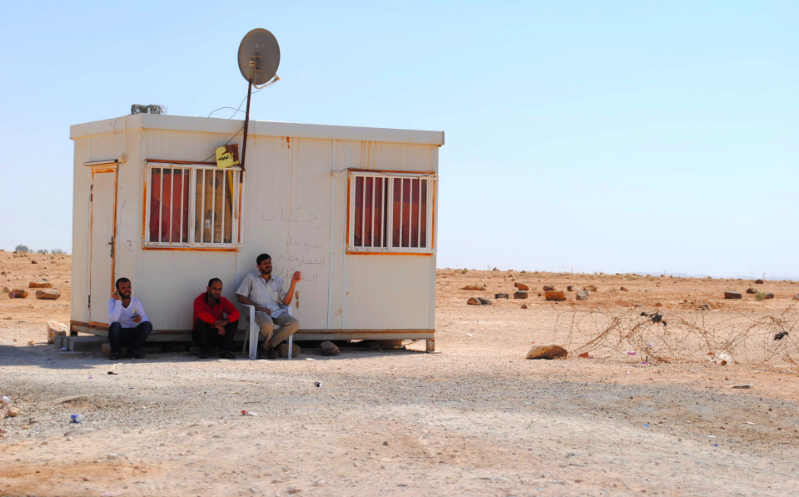
[Syrian refugees wait at the Ruba’ al-Sarhan (Registration Center) in al-Mafraq, Jordan 07/2014]
Circles of Syrian Doctors Working in Jordan
Most of the private hospitals in Jordan that were previously mentioned only started receiving Syrian patients from the borders in the summer of 2013. At this time, Syrian doctors in Jordan organized to request entire floors of private hospitals in Amman in which to treat injured Syrians. In interviews I conducted at a handful of these hospitals, Syrian doctors characterized their groups as informal. The doctors had been brought together by community networks, often originating in Syria, as well as by a common desire to provide relief to war victims. Before March 2011, many of these doctors were working at Syrian government hospitals. Once uprisings throughout the country began, these hospitals became dangerous spaces, and soon, completely off-limits, to injured protesters and anyone perceived to be siding with the opposition. Even now, Syrian doctors who treat the civilian victims of regime violence continue to face threats, detention, and death at the hands of the Syrian government. Today, Syrian doctors who remain working in Syria’s field hospitals stay connected to those who have left for neighboring countries through support networks that mobilize funds, medical supplies, and medicine for Syria’s injured and ill. They also use their connections to provide synchronized responses to daily events (attacks) in south Syria and to personally monitor trauma victims as they make their way to private ICUs in Jordan.
In an interview I conducted with a Jordanian Health Ministry official, he stated that there was a procedure in place for Syrian doctors to obtain a Jordanian license and therefore practice medicine legally in their host country: they must first pass the Jordanian Medical Council exams, register with the state, and join the Jordan Medical Association. Based on various Syrian doctors’ accounts, the process of obtaining a Jordanian license is not only difficult, but essentially unheard of. Once again, the discrepancy between official policy and actual practice is clear. These accounts align with Jordan’s attempts to keep Syrians from entering the labor market, both by making work permits expensive and difficult to obtain, and by generating fear of the consequences for being caught working illegally.
On paper, unregistered Syrian doctors are restricted to managing the logistics of patient transfers. Yet with the continual influx of war victims from the borders and few Jordanian doctors to treat them, many Syrian doctors are compelled to defy Jordan’s policies in order to treat Syrian patients. In the hospitals I visited, Jordanian doctors often help give the guise of compliance by briefly visiting Syrian wards each day to sign off on official documents and register the surgeries of Syrian patients. Thus, they help Syrian doctors avoid the state’s punitive measures for Syrians who are caught working illegally.[1] In order to deal with the Health Ministry’s monthly visits, Dr. “Al-Ghouta”, instated a protocol for Syrian doctors in his hospital to hide in the basement, and Dr. “Muadamiyat” uses a fake patient ID to disguise himself. The same health ministry official I interviewed acknowledged that most Syrian doctors in Jordan quite literally work underground. For over a year, it seemed that as long as Syrian doctors continued filling in for the lack of doctors treating incoming wounded Syrians, and as long as they steered clear of politics, the Jordanian government would continue to turn something of an acquiescent blind eye to these predominantly wageless doctors. However, Human Rights Watch has reported ongoing deportations of Syrian medical workers “caught” treating Syrian patients at Ramtha Public Hospital as well as at private hospitals around Jordan.[2] It is safe to conclude that Jordanian authorities may have already or may soon close rehabilitation centers and Syrian hospital wards that were a part of this study.
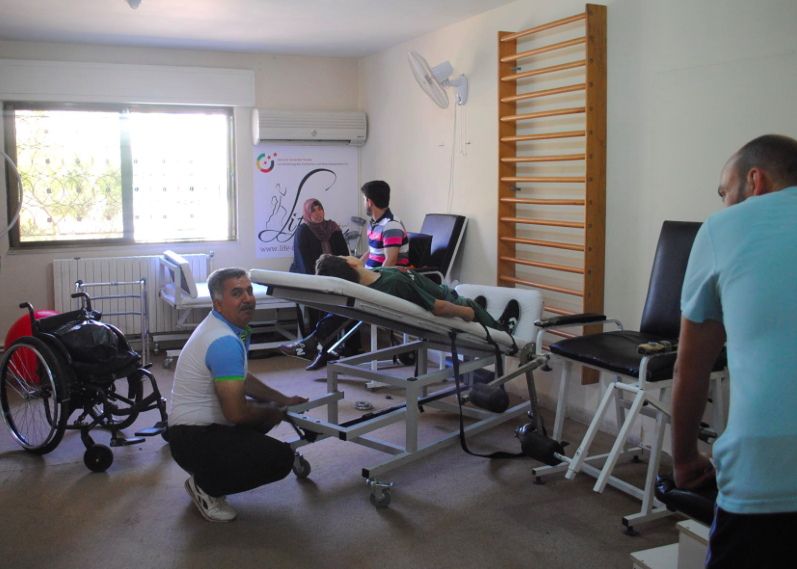
[Syrian Rehabilitation Center, Irbid, 08/2014]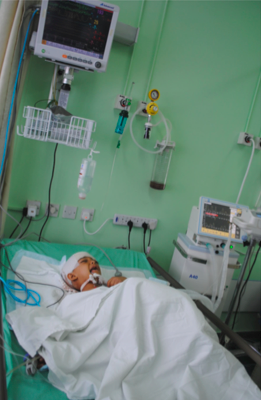
[Victim of airstrike treated in ICU in Amman 08/2014]
Monitoring a Situation in Flux
Jordan’s steady deviation from humanitarian obligation reveals the kingdom’s apprehensions toward hosting another refugee population, long-term. It is fitting to ask if Jordan’s growing impatience stems from the utter lack of a solution to Syria’s persistent war. In light of the escalating security concerns posed by cooperating with the FSA, it seems the costs of quietly supporting Syria’s moderate opposition are becoming too high. In several of its recent political moves, Jordan is sending implicit messages to Syrian refugees and to the international community—its desire to reduce its involvement in Syrian affairs. However, could it also be that after almost four years of conflict, the Jordanian government, like a significant number of Syrian refugees, is considering reconciliation with al-Asad’s regime?[1]
Most importantly for this research, it is crucial to ask how Jordan’s evolving political agenda will affect its treatment of Syrian refugees and the consequent wellbeing of these communities. Can their informal networks withstand repressive host country policies? How will underhanded practices like repatriation undermine the resilience and cohesiveness of the larger Syrian community?
Life is on halt for Syrians in Jordan who have little access to higher education, healthcare, and work. For many, Jordan is just a temporary stop before refugees move on to Turkey or make the dangerous trip into Europe. As European Union members, Australia, and now the United States offer thousands of resettlement and asylum opportunities to Syrians, the common perception is that better treatment and possibilities await them there.[2] Jordan may be an increasingly undesirable place of refuge for Syrians, but most have no other option than to stay and wait it out.
[1] UN General Assembly, Convention Relating to the Status of Refugees, 28 July 1951, United Nations, Treaty Series
[2] Wiktorowicz, Quintan. 2001. The management of Islamic activism: Salafis, the Muslim Brotherhood, and state power in Jordan. Albany, NY: State University of New York Press, pg. 9.
[3] Singerman,Diane, 1995. Avenues of participation, family, politics, and networks in urban quarters of Cairo. Princeton, N.J.: Princeton University Press.
[4] Singerman, Avenues of Participation, 134
[1] Al-Abed, Tareq. “Who Controls Syrian Border Crossings?” Al-Monitor: The Pulse of the Middle East.” N.p., 17 July 2014. Web.
[2] Tilley, Tom. “Refugees Catch Bus Hell to Escape Harsh Conditions of Camp.” ABC News. N.p. 5 Nov. 2014. Web.
[3] Akram, Susan M. and Boston University Law Students. Protecting Syrian Refugee: Laws, Policies, and Global Responsibility Sharing. Publication. P.p.: Boston U Law School, 2014. Print.
[4] Sherlock, Ruth. “Jordan Repeals Free Medical Aid for Syrian Refugees.” The Telegraph. Telegraph Media Group, 28 Nov. 2014. Web.
[5] “Labor Ministry Considering New Measures for Working Syrians.” Jordan Times. Petra, 2 Aug. 2014. Web.
[6] Akram, Protecting Syrian Refugees, 63
[1] Wiktorowicz, The Management of Islamic Activism, 37
[2] Wiktorowicz, The Management of Islamic Activism, 17
[1] Al‐Abed,“Who Controls Syrian Border”
[1] UN General Assembly, Convention Relating to the Status
[2] Davis, Carlo. “Jordan ‘Forced’ into Syrian Intervention? Economic Conditions Pressure Abdullah to Allow U.S. Presence, Analysts Say.” The Huffington Post. 18 April 2013. Web.
[3] Frelick, Bill, 2006. Silent treatment: fleeing Iraq, Surviving Jordan. New York: Human Rights Watch, 80.
[4] Montoya, Katy. “Humanitarian Crisis: Health Care and Jordan’s 600,000 Syrian Refugees.” Informed Comment: Thoughts on Middle East, History, and Religion. 16 October 2014. Web.
[5] Davis, Rochelle, Abbie Taylor, and Emma Murphy. “Gender, Conscription and Protection, and the War in Syria.” Refugee Studies Centre, Oxford University, Sept. 2014. Web.
[1] Akram “Protecting Syrian refugees,” 63
[2] “Jordan: Syrian Medical Workers Deported.” Human Rights Watch. 8 Dec. 2014. Web.
[1] Stevens, Matthew. “Dreaming of Home: Syrian Refugees in Jordan’s Cities- Will They Repatriated?” Syria Comment RSS. N.p. 16 Sept. 2014. Web.
[2] Nguyen, Katie. “UN Says Rich Nations Pledge to take 100,000 Syrian Refugees.” Reuters. 09 Dec. 2014. Web.
